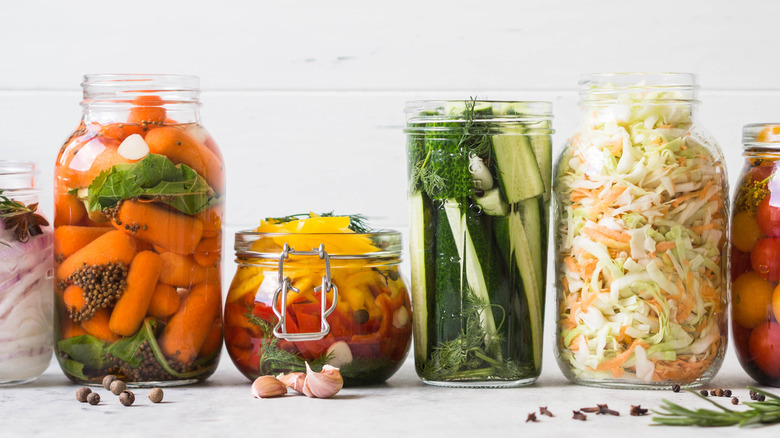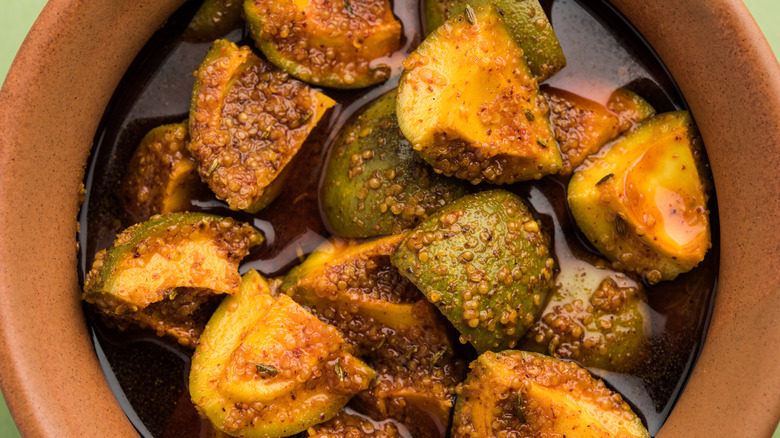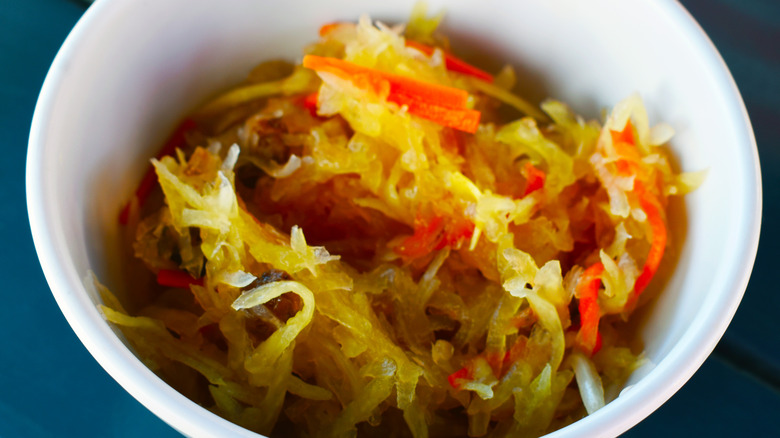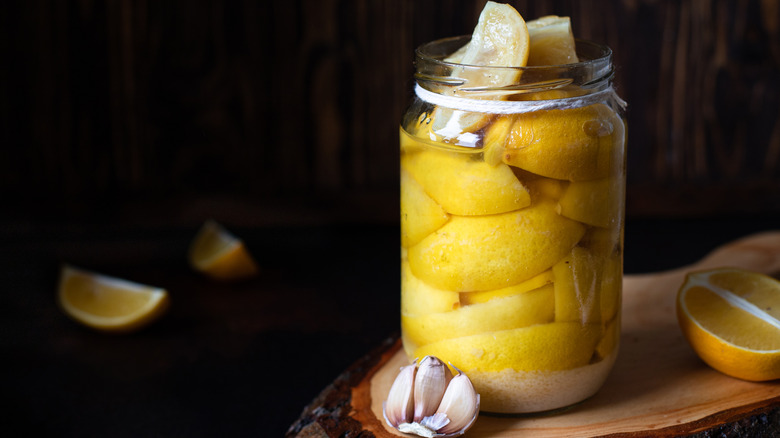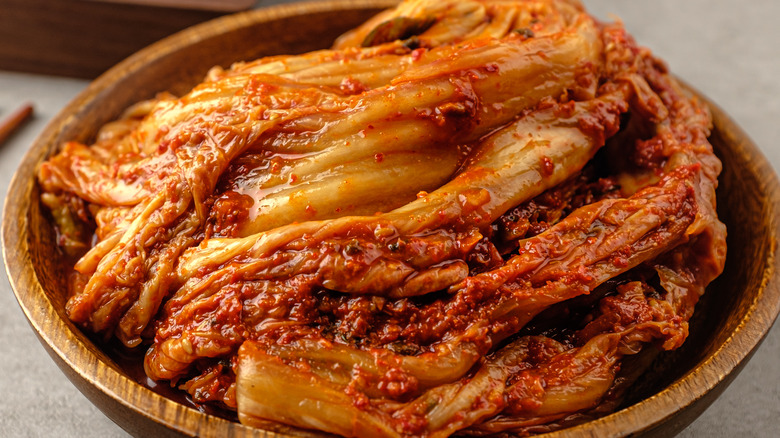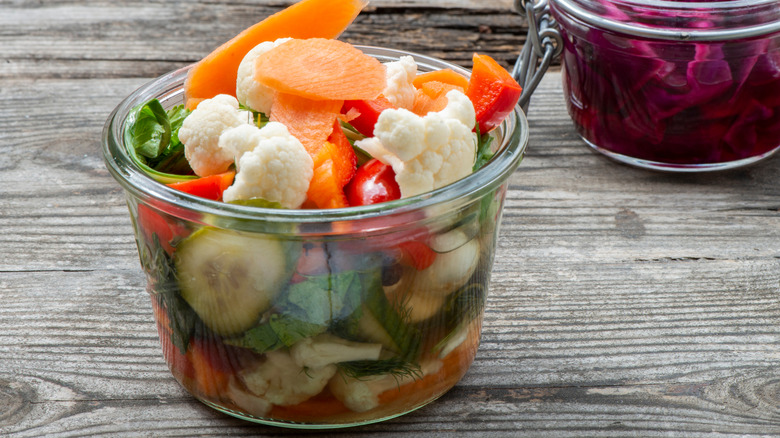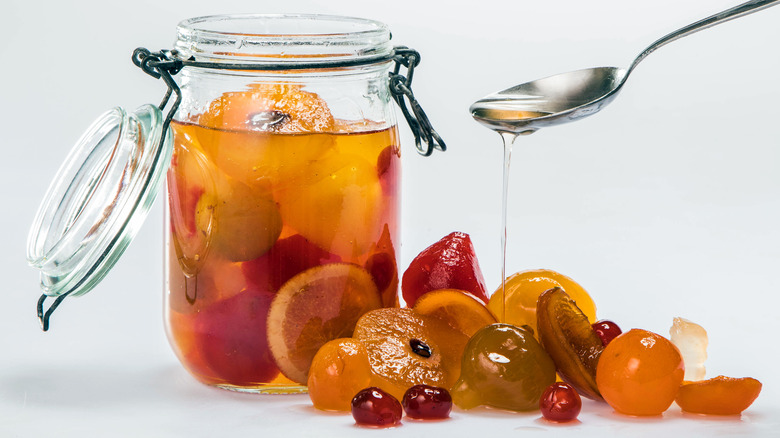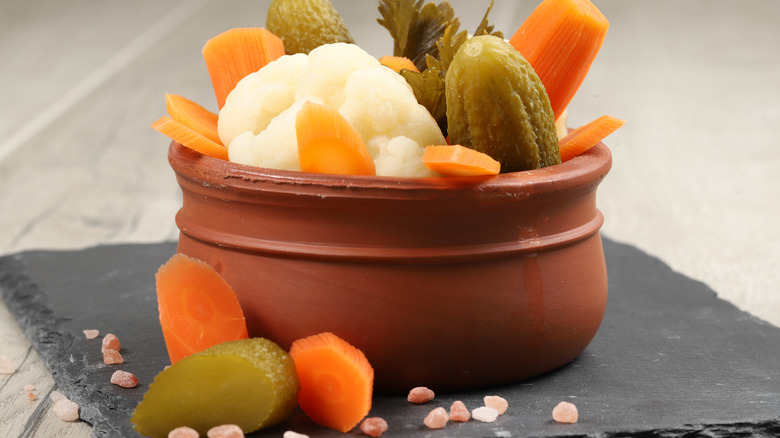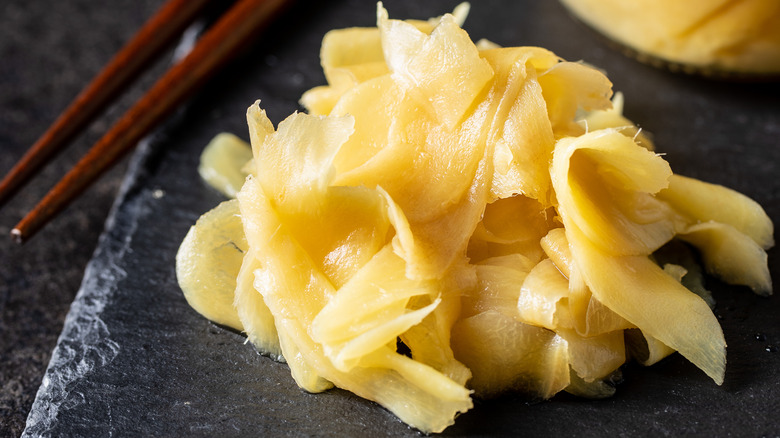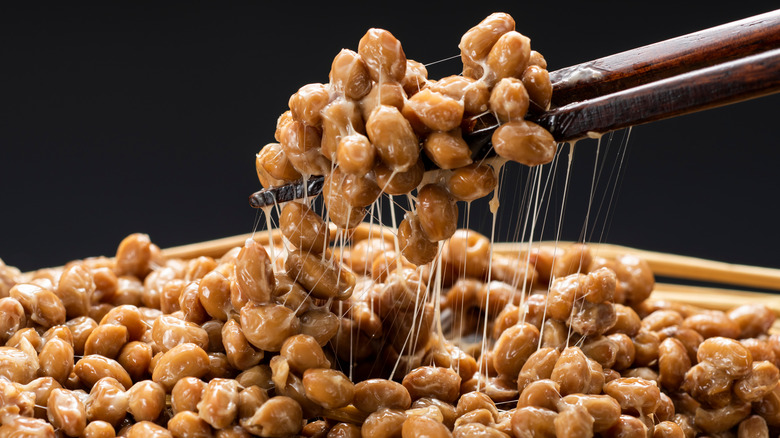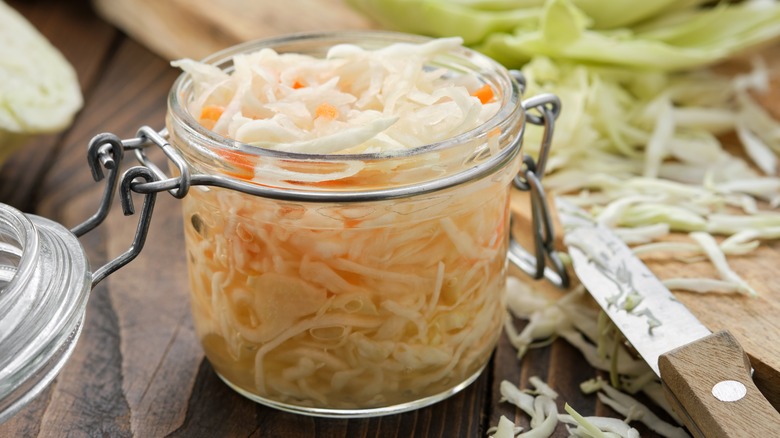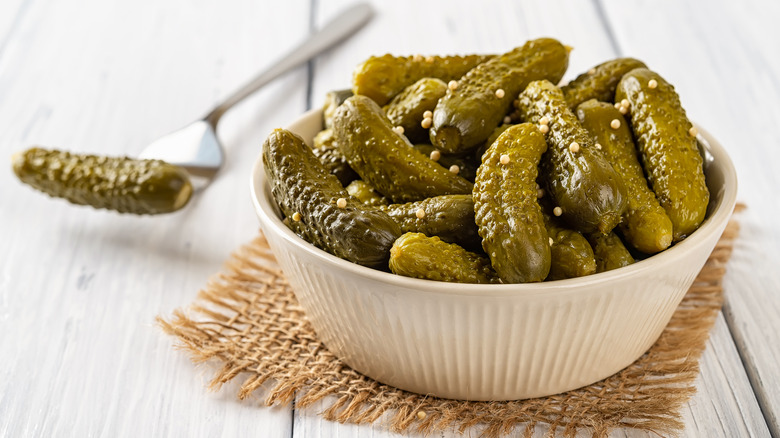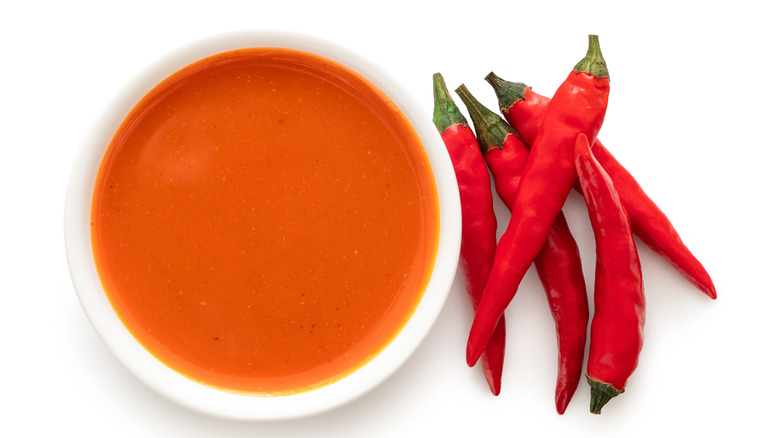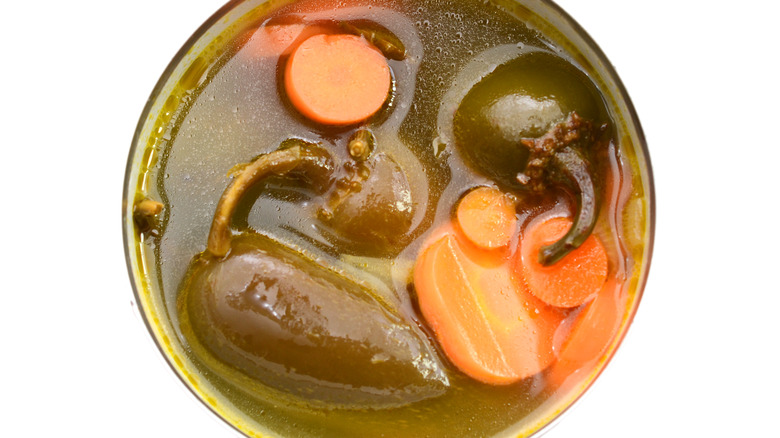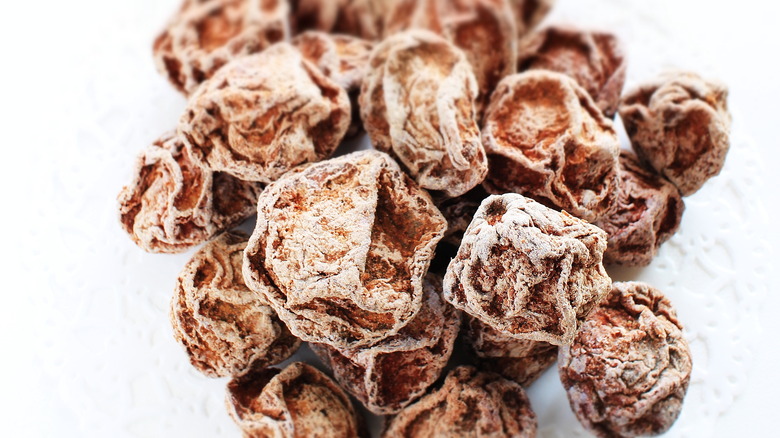Pickled Vegetables From Around The World
We may receive a commission on purchases made from links.
What is a pickle? Well, that depends on who you're asking. Here in the United States, the first thing that probably comes to mind is a sweet or sour, crunchy sandwich condiment. These pickles are generally made by placing cucumbers in a glass container and covering them with a mildly acidic mixture of vinegar, water, salt, herbs, and spices (via Mountain Feed). This ultimately transforms the humble vegetable into a salty, sour, crunchy snack.
According to the NY Food Museum, pickling has been around since the ancient Mesopotamians (circa 2400 B.C.), and throughout history, pickled foods have been touted for having almost magical benefits (via History). It was believed that a diet rich in pickled foods contributed to Cleopatra's legendary beauty, while Julius Caesar thought it would increase both the physical and spiritual stamina of his troops. In the Age of Exploration, scurvy (vitamin C deficiency) was treated with pickled and fermented foods. Flash forward to the year 2000; the Philadelphia Eagles credited pickle juice as their endurance liquid of choice. (Bye-bye, Gatorade).
Pickling is a form of food preservation that was born out of necessity. It can be found across all cultures, in one form or another. Pickling prevents food from spoiling during extended travel and provides nourishment during harsh seasons when food is scarce. The best part about pickling — besides the taste — is that pretty much anything food (especially vegetables) can be pickled.
Aam Ka Achar (mango) - India
Achaar (or achar) is an umbrella term for the beloved Indian pickle (via MasterClass). While this sour staple has multiple variations (from gooseberries to lemons to cucumbers and lotus stem), pickled green mango is the classic. Known as aam ka achar (or aam ka achaar), green pickled mango (alias mango pickle) uses unripened rajapuri mangoes — the largest of the Indian varietals — as the main ingredient (via Spice Up The Curry). Aam ka achaar is typically made during the summer months since mangoes of all shapes and sizes are in season at that time. Fenugreek, ground mustard seed, salt, turmeric, chili powder, asafoetida (or asafetida), and mustard seed oil are the other key players in creating a traditional aam ka achaar.
The mustard oil is cooked over a medium flame until it begins to smoke and then is allowed to cool down. The green mango is cubed, placed in a sealable jar with herbs and spices, and covered with potent mustard oil. The result is a spicy, tangy, and complex condiment that can revive even the blandest and unassuming dishes (like white rice or eggs).
Atchar (green papaya) - Philippines
Similar to India's aam ka achaar, the people of the Philippines have their own version of pickle that also utilizes unripened produce. Known simply as atchara, green (unripened) papaya is shredded with ginger, carrots, onion, and garlic and placed in an airtight container with the pickling solution. This fermented pickled does not use mustard oil as its primary marinating liquid. Instead, it opts for the typical vinegar, salt, and sugar brining solution. Different regions also have slight variations in what they add to their pickled green papaya, according to the food blog EatPH. Some recipes add raisins or pineapple, while others substitute radish for the green papaya.
Atchara looks like sauerkraut and lends a crunchy, tangy, and somewhat spicy addition to barbecue chicken and pork. It's also served alongside the traditional (and incredibly filling) Filipino breakfast consisting of fried garlic rice, egg, and beef or cured meat, known as Tapsilog (via The Spruce Eats).
L'hamd Markad (preserved lemons) - Morocco
Preserved lemons are a staple in Moroccan and middle eastern cuisine and are made with only a few ingredients: Lemon, salt, lemon juice, salt, a few herbs and spices ... and more salt. Called L'hamd markad in Morocco, preserved lemons were first referenced in an 11th-century Arab Mediterranean recipe, as mentioned in The Encyclopedia of Kitchen History by Mary Ellen Snodgrass.
MasterClass states that L'hamd markad has an almost umami-like quality, where they're not too sweet but not overwhelmingly sour and satisfy both the acid and salt requirements for a dish. The preserved fruit is 100% edible — rind and all — and can be added to chutneys and vinaigrettes, but it also holds up well with salty foods like olives. L'hamd markad pairs well with chicken, especially when cooked in a Dutch oven or tagine, which allows the juices from all the ingredients to simmer and marry together. While it's not incredibly common, preserved lemons can be used in place of lemon juice for dips and spreads and go well in hummus (via OMG! Yummy) or guacamole-type dips, olive tapenades, or even Indian raita.
Kimchi (Napa cabbage) - South Korea
Kimchi doesn't have the most appetizing smell (not that fermented foods are that fantastic smelling to begin with). Its main ingredient is cabbage, which contains organic compounds that produce a sulfuric smell when cooked or consumed (via Atlas Bio Med). Despite its assault on your olfactory sense, Healthline states that this traditional fermented dish totes multiple health benefits. (And if you're not big on the cabbage scene, don't worry — there are at least 14 different types of kimchi, so there's a little something for everyone.) The most well-known kimchi uses Chinese cabbage (also known as Napa cabbage), and can sometimes contain daikon radish and carrot, writes Asian Recipe. Its bright red color comes from gochujang, with garlic, scallion, ginger, and fish sauce contributing to its funky aromatics.
In its unfermented form, Chinese cabbage is incredibly nutrient rich and high in vitamins A, C, and K. In fact, one serving (1 cup or 150 grams) contains 55% of your daily recommended vitamin K, as well as 22% of your required vitamin C. Because kimchi is fermented, as opposed to pickled or brined, it also contains lots of healthy bacteria like probiotics, which are incredibly beneficial for digestive health. It's also purported that kimchi can help in inflammation, may reduce the signs of aging, and support heart health.
Giardiniera (vegetable relish) - Italy
Perhaps you've been to an Italian eatery and were served brightly-hued, spicy vegetables — or a relish — with your meal. These are giardiniera — vegetables marinated in oil, vinegar, and spices. On the East coast, they're generally served as part of an antipasto or even on their own. But for a majority of the rest of the United States, giardiniera is more of a relish or sandwich topping consisting of chopped-up vegetables.
According to BonAppetit, the latter of the two has origins in 19th-century Chicago, the home of the Italian beef sandwich. Chicago-style giardiniera consists of a medley of finely chopped, almost pulverized vegetables marinated in vinegar and mixed with olive oil. The outcome is a condiment that's akin to a relish or spread. Italian-style giardiniera is more like a pickle — less chop, more pop in your mouth type of deal. Both variations contain similar veggies like red bell peppers, cauliflower, carrots, onion, and sometimes celery. They can also include spicy peppers to give an extra flavor kick to your meal.
Mostarda di Frutta (candied fruit in mustard syrup) - Italy
Described as something between a relish, a chutney, and a pickle, mostarda di frutta is a mixture of fresh and dried fruits stewed in vinegar (or wine) and mustard (via MasterClass). It can sometimes look like a jam or jelly, or like fruit chunks in syrup. (Mustard syrup? Uh...) It's typically served alongside meats and cheeses and is made using only three core ingredients for preservation: Water, mustard, and sugar (and the actual fruits themselves). Mostarda di frutta (or mostarda, for short) is a food item that goes back to the 16th century, according to Lazzaris, an Italian company specializing in preserves, spreads, and of course, mostarda.
But why mustard? It seems like a rather peculiar combination — apricots, cherries, figs, pears, apples, quince, prune, possibly pumpkin, all cooked down with sugar, shallot, rosemary, bay leaf, and of course, mustard powder and mustard seed. It's not just a happy accident. The mustard serves an essential purpose. According to Spread the Mustard, this ingredient has natural antimicrobial and preservative qualities. The same goes for sugar, which extends the shelf life of foods by leeching out moisture (which is necessary for bacteria and yeast to grow and thrive). If you remove the moisture, you remove the mold.
Turşu (mixed vegetables) - Turkey
Turşu is a pickled vegetable appetizer that's an essential part of mealtime and can be found pretty much everywhere from Afghanistan to Armenia, Croatia, Bulgaria, Greece, Turkey, and the Balkans. This pickled veggie side dish has many guises (albeit similar), like torshi, torusi, turshiya, toursi, and turšija, depending on where you're eating it (via TasteAtlas). The word "torsh" actually means "sourness" in Persian (via Dining Diaspora). Like most (if not all) pickled and preserved foods, turşu was a dish created to prolong the shelf life of veggies so that they could be eaten through the winter months.
When it comes to transforming farmer's market fare into pickles, turşu doesn't discriminate — any vegetable is fair game (and all dependent on the culture that's making it). Common veggies are the typical cucumbers, carrots, and onions, but also eggplants, cauliflower, green beans, zucchini, beets, grape leaves, and even turnips. Lucky for you, the actual pickling liquid isn't that difficult to make and requires only three ingredients: Water, vinegar, and salt. It can't get much easier than that.
Gari (ginger) - Japan
When you order sushi, you've probably noticed that along with your California and Philadelphia rolls, you're served a small dollop of nose-searing electric green paste and a small pile of sweet and spicy, thinly sliced pink ribbons. These slices are gari, better known as pickled ginger, and it comes in two different varieties (via JapanCentre). The first is called beni shoga — ginger marinated in plum vinegar. This condiment is supposed to be eaten with savory dishes, like donburi or yakisoba, and acts as a flavor contrast to these dishes because its taste is so biting. Beni shoga tends to be fluorescent pink. Sushi gari is young ginger marinated in sugar and vinegar and is typically served with nigiri and sushi. Its color ranges from pale yellow to light pink.
When it comes to eating gari, there's a certain way to go about it, and using it as a garnish for your sushi isn't the right way. (Oops.) According to the Australian food blog GoodFood, gari is meant to be a palate cleanser. For example, when you're switching from one strong-tasting fish to another (like tuna to salmon), the ginger will remove any lingering taste so that you can appreciate the different nuances of the new bite. It also covers up any raw fish smell that might be present.
Nattō (soybeans) - Japan
Nattō — a dish consisting of fermented soybeans — is one of those foods that you either love or hate. (It's nattō for everyone.) But what makes it so difficult to get down is that it tastes like a mixture of coffee, onions, and old brie cheese and has a stringy, sticky, almost slimy texture (via VeganCalm). It's tough to nosh down on if you're not accustomed to it.
Though its origins aren't precise, nattō retailer NYrture notes there are a couple of stories to pull from. Both seem to center around soybeans wrapped in rice straw (which apparently could grow Bacillus subtilis natto). The straw parcel was then somehow (accidentally) exposed to a natural heat source, which instigated soybean fermentation. Whatever the story, consumption of some form of nattō can be traced back to the beginning of neolithic Japan, called the Yayoi period, from 300 B.C. to 300 A.D.
When it comes to popularity, nattō is to Japan and yogurt is to America (both fermented and typically eaten at breakfast): Miso soup, pickled vegetables, and rice with nattō would be the equivalent of eggs, bacon, and toast in the states. It's a high-protein food rich in vitamins and minerals, helps with digestion (thanks to those lovely probiotics found in fermented foods), helps your heart, and contributes to bone density (via Healthline).
Sauerkraut (green cabbage) - Germany
Sauerkraut is to Germany as the doughnut is to America — neither originated from said location. That's right, though the name is German (and translates to "sour cabbage"), sauerkraut originally has roots in China (via The Baltimore Sun), where cabbage soaked in rice wine was fed to the individuals who were building The Great Wall of China. It was nutritious — VeryWellFit notes sauerkraut is high in micronutrients and probiotics — kept them healthy and didn't need refrigeration. These are probably some of the main reasons why Genghis Khan took the recipe and modified it, switching out salt for wine. When the Tartars (Mongolian tribes) made their way through Europe soon afterward, they took the dish with them. And thus, Germany adopted the kraut as part of their national heritage.
Sauerkraut isn't for the faint of heart. As soon as you crack open that lid, you'll know you're about to eat something unique. That's because it's undergone a slightly different method of preservation called fermentation, where microorganisms like yeast or certain bacteria break down carbs into alcohol or acids (via Healthline). Sauerkraut is simply cabbage that's been salted and left to ferment at room temperature.
Cornichon (baby cucumbers) - France
A cornichon is France's answer to the pickle. It's made with a specific type of cucumber called a gherkin, which comes from the Dutch word "gurken," meaning small pickled cucumber (via MasterClass). (The French call them cornichon, the English call them gherkin. To-MAY-to/to-MAH-to.) Gherkins are native to India and have a rougher, bumpier texture and are harvested at around 1 to 2 inches. They're such a popular condiment that as of January 2022, India has become its largest exporter, producing roughly 15% of the world's gherkins to at least 20 different countries (via The Free Press Journal). For their cornichon makeover, gherkins can be sweet or sour. They are typically soaked overnight in salt and then soaked in vinegar, heated, and then packed into jars with different herbs and spices (via The Spruce Eats).
Cornichons are typically part of a charcuterie board, as their crisp, twangy taste helps cut the decadent creamy and salty richness of meats and cheeses. Besides tasting delicious, pickled foods like cornichons and sauerkraut can positively impact health and have been proven to restore electrolytes, treat muscle cramps, and control blood sugar (via Medical News Today). They might also help treat symptoms of depression and anxiety. This is because the probiotic nature of fermented foods benefits your gut microbiome, which, in turn, helps with the production of serotonin (via All Recipes). So the next time you're feeling a bit down, grab some cornichons. If anything, they're fun to eat.
Conserva de Pimenta (malagueta peppers) - Brazil
Courtesy of Portuguese maritime explorers who spent the 15th and 16th centuries charting new naval routes, mapping coastal lands, and buying and selling expensive items like spices, the malagueta pepper was first discovered in the Caribbean and then brought back to Portugal (sharing the good financial news), and finally transported to Brazil (via Club Lusitano). While it doesn't seem like that fantastic of a discovery, chili peppers at that time were big money items, right up there with gold and silver. Peppers like the malagueta (alias piri-piri and birds-eye chili) were so financially valuable that they were even willed to family members upon the owner's death.
According to the blog PepperScale, the malagueta pepper is a staple food item in Brazilian and Portuguese cuisine. These 2-inch chilies are sweet, tangy, and spicy — really spicy — between 60,0000 to 175,000 SCU (just under the Tabasco pepper). The malagueta pepper is 23 times hotter than the typical jalapeño. In their raw form, these little guys are commonly used in soups, stews, and pretty much any other Brazilian or Portuguese dish you can think of — piri-piri chicken sound familiar? They are also frequently sold in jars as pickled peppers (via Amazon) or in hot sauce form.
Escabeche (jalapeños and carrots) - Mexico
If you want to elevate your tacos to another level, you'll want to pay attention to this acidic and flavorful taste addition. Escabeche belongs to multiple cultures, though it mainly has roots in Spanish, Portuguese, Filipino, and Latin American cuisines (via PortaMX). According to the Los Angeles Times, it's also believed to have origins in 13th-century Arabic cultures. As expected, each country's version of escabeche is reflective of that area — for example, Spaniards have been known for their fish escabeche since Christians observing Lent needed a protein that was considered okay to consume. All escabeche dishes contain similar ingredients: A protein (meat or fish), or sometimes vegetable(s), vinegar, citrus, garlic, herbs (like bay leaf and peppercorns), smoked paprika, and saffron. Most are cooked in a sauce made from these components, so the dish is almost like a stew.
However, in Latin American countries like Mexico and El Salvador, their version of escabeche is typically more like a pickled vegetable side dish or a condiment than a vinegary stew (via Saveur), where chicken or fish is swapped out for carrots, onions, or jalapeños. It's commonly served alongside main dishes to add an acidic bite to the meal.
Huamei/Li hing mui (plum powder) - China
Preserved fruits and vegetables have a long history in China and Asia, and huamei is part of that story. Preserved foods hold up well during travel and also help soothe muscle cramps caused by long and arduous travel (via Snack Hawaii). In the mid to late 1800s, there was a large influx of Chinese immigrants who worked as contract laborers on sugar plantations, according to Hawaiian History. On their trek across the Pacific Ocean, one of the items they brought was huamei, or preserved plums.
Today, huamei — better known as li hing mui, which translates to "traveling plum" (via Onolicious Hawaii) — is sold in its dried, preserved plum form. It's also available as a powdered mixture made of licorice, salt, sugar, dried and ground up plum skin, water, and sometimes aspartame and food coloring (via Look Into Hawaii). It's tangy, salty, sweet, and according to BonAppetit, also considered to be a magical cure-all. Though definitely an acquired taste, li hing mui can be added to most foods, giving them a tangy, unique, and somewhat indescribable taste. In Hawaii, it's common to see li hing mui powder sprinkled on fresh or dried fruit, candy, shaved ice, added to sauces and vinaigrettes, and even subbing in for the salt rim on a margarita.
